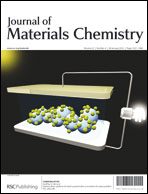Lithium rich materials Li[Ni0.2Li0.2Mn0.6]O2 have been successfully modified by coating a thick layer of electrochemical active delithiated oxides MnOx (1.5 < x ≤ 2). The morphology observations and XRD results show that the thickness of coating layer of the modified sample 0.10MnOx·0.90Li[Ni0.2Li0.2Mn0.6]O2 is about 20 nm and there is a tiny amount of spinel structure in the coating layer. The electrochemical performance results indicate that the thick coated materials 0.10MnOx·0.90Li[Ni0.2Li0.2Mn0.6]O2 exhibit higher reversible capacity (265 mAh g−1 after 30 cycles), higher initial coulombic efficiency (90.2%), better low rate discharge capability (above 238 mAh g−1 at 1 C, 222 mAh g−1 at 2 C) and superior cycle-ability (30 cycles: 88.9%, subsequent 50 cycles after rest: 92.4%) than those of the pristine sample and conventional coated sample, respectively. The cycle voltammograms show good reversibility of the 0.10MnOx·0.90Li[Ni0.2Li0.2Mn0.6]O2 sample. The EIS tests reveal the charge transfer resistance of 0.10MnOx·0.90Li[Ni0.2Li0.2Mn0.6]O2 is lower than that of the pristine sample and conventional coated sample, respectively. Our research findings may provide significant new insights on surface modification of lithium rich cathode materials for the next generation of lithium ion batteries.

You have access to this article
 Please wait while we load your content...
Something went wrong. Try again?
Please wait while we load your content...
Something went wrong. Try again?


 Please wait while we load your content...
Please wait while we load your content...